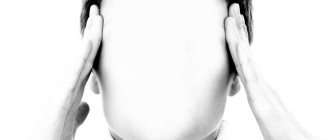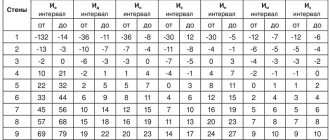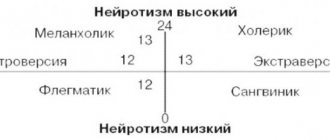Personality accentuations
Attempts to identify and characterize certain types of characters based on the most pronounced accentuations have been carried out for a long time; many famous psychologists and scientists are directly involved in this. The earliest classification was developed by the German leader in the field of psychology E. Kramer. The divisions according to the character types of his American colleague W. Shannon look a little different. The modern classification uses the works of K. Leonhard, E. Fromm.
This article discusses the definition of personality accentuation according to the questionnaire of A. E. Lichko.
Basic principles for systematizing accentuations
In the process of taking a test to identify characteristic personality traits, you should adhere to the following key points:
- bright accentuations of character are formed at an early age and are stable throughout life;
- combinations of strong traits and weak manifestations of individual personal qualities cannot be built randomly, they create stable relationships that determine the typology of character;
- Almost all people from any social group can be classified as a certain type of character.
Accentuations as an extreme feature of the norm
According to psychologist A.E. Lichko, the highest limit for the development of accentuation should not exceed the normative limits of psychological deviations, beyond which a pathological change in personality occurs. In adolescence, such accentuations, bordering on pathology, are often observed and have the peculiarity of a temporary state of mind.
In a person, affective neuroses and borderline states, behavioral characteristics, and predisposition to somatic diseases depend on the type of accentuation. Accentuation can act as an important component of endogenous mental diseases and reactive nervous disorders. The most striking features should be taken into account when compiling a list of rehabilitation measures, psychological and medical recommendations.
Accentuation determines the future profession, makes it difficult or difficult to adapt to society . This indicator is important when choosing programs of psychotherapeutic activities, in the sense of obtaining the most complete effect from group, individual, directive or discussion psychotherapy.
The most fully developed character traits appear during growth and puberty, then gradually smooth out towards adulthood. Accentuations can appear only in certain conditions, and in normal circumstances they are almost undetectable . Sometimes the manifestation of accentuations in human character can lead to difficulties in adaptation in society, but such phenomena are temporary and are subsequently smoothed out.
Degree of manifestation of accentuation
The severity of bright and strong characteristic personal qualities leads to a division into two types:
- obvious accentuation;
- hidden accentuation.
Explicit accentuation
Refers to extreme manifestations bordering on the norm. Constant personality traits determine an individual’s attitude towards a certain type of character, but pronounced traits do not lead to difficulties with adaptation in society. People choose a profession that corresponds to their developed abilities and certain capabilities.
Vivid personality indicators become more acute during adolescence, which, when interacting with certain psychogenic factors, can lead to disruption of smooth communication with other individuals and deviations in behavior . After reaching adulthood, the features remain significantly pronounced, but are smoothed out, and communication in society occurs smoothly, without incident.
Hidden current of accentuation
This degree of development of the most significant character traits rather refers to normal options; we can say that accentuation (the manifestation of bright personal indicators) does not appear at all. But those assessment indicators that have the highest value can manifest themselves during tests in situations of psychologically heightened background, after severe mental trauma and experiences.
Types of accentuations according to the classification of A. E. Lichko
The characters of people, depending on combinations of certain personal indicators, are divided into the following types:
- labile , characterized by a sharp change in mood and behavior depending on external circumstances;
- cycloid , with a set of traits with a tendency to certain changes in behavior during a certain period;
- asthenic , with an indecisive character prone to anxiety, prone to rapid fatigue, depressive states, irritability;
- the fearful type involves timid and shy communication when absolutely necessary, impressionability from contacts with others, a feeling of one’s own inferiority;
- psychasthenic individuals show excessive suspiciousness, anxiety, doubtfulness, are prone to self-examination, preferring traditional actions;
- a schizoid individual isolates himself from society, adaptation in society is difficult due to isolation, emotional poverty, indifference to the suffering of others, and immature intuition;
- the stuck type of paranoid orientation has increased irritability, ambition, inadequate touchiness, and constant suspicion;
- epileptoid characters exhibit a melancholy and angry mood, impulsive behavior, uncontrollable outbursts of anger, cruelty, retardation of thinking, pedantry, slow speech pronunciation;
- the hysterical demonstrative type manifests itself in a tendency towards deceitful speeches, pretense, acting to attract attention, adventurous solutions to issues, lack of conscience, vanity;
- the hyperthymic type is distinguished by a cheerful disposition, talkativeness, active activity, scattering of attention on various interests without pursuing them to completion;
- dysthymic type is constantly depressed with reduced activity, excessive seriousness, sadness and depression;
- an unstable type of extroverted behavior, susceptible to the influence of others, loving new impressions, events, sociable, with the ability to easily contact new people;
- conformist is prone to subordination and allows his own dependence on the opinions of others, does not know how to self-critically perceive shortcomings, conservative, has a negative attitude towards everything new.
Classification of types of character accentuation
Hyperthymic type
Hyperthyms are very sociable, even talkative, active in work, very mobile, and restless. They love to be the center of attention and command the group. They have many hobbies, but, as a rule, they are superficial and pass quickly. During physical activity that requires activity and energy, they retain strength for quite a long time. Almost always in a good mood. Accuracy is not their distinguishing feature.
Sexual feeling awakens early, can be strong, and reactions associated with the formation of sexual desire manifest themselves clearly. Hyperthyms enter into sexual relationships early, but romantic interests usually do not last long. They strive to quickly have sexual intercourse with the object of their love, and if this does not work out, they do not refuse casual acquaintances.
Cycloid type
This type is characterized by repeated alternation of periods of full strength, energy, health, good mood and periods of depression, decreased performance, which is why they are called cycloids. For cycloids, the phases are usually short and last 2-3 weeks. During periods of depression, they experience increased irritability and a tendency toward apathy. At this time, society irritates them, they avoid meetings and companies, and become lethargic homebodies.
Depression can be replaced by a normal state or a period of recovery, when the cycloid turns into hyperthymia, quickly makes acquaintances, strives for company, claims leadership and quickly makes up for lost time.
Labile type
In behavior, representatives of this type are unpredictable and extremely changeable in mood. The reasons for an unexpected change in mood can be different: a word dropped by someone, someone’s friendly glance. In connection with their mood, the future is either painted with bright colors, or appears gray and dull. The attitude towards people is the same: for them the same ones are either cute, interesting and attractive, or boring, boring and ugly.
Poorly motivated changes in mood sometimes create the impression of frivolity, but this is not so. They are capable of deep feelings, great and sincere affection. And some pleasant conversation, interesting news, a fleeting compliment can lift their spirits, distract them from troubles until they remind themselves again.
Asthenoneurotic type
Characterized by suspiciousness, capriciousness, increased fatigue, and a tendency toward hypochondria (morbid suspiciousness, expressed in an obsession with the idea of illness). They listen carefully to their bodily sensations and willingly undergo treatment. In their thoughts about the future, concern for their own health occupies a special place. They are drawn to friends and company, but quickly get tired of them, after which they seek solitude or communication with a close friend.
Sensitive type
Their increased sensitivity and impressionability are combined with high moral requirements for themselves and others. They do not like large companies and outdoor games. They are timid and shy with strangers and give the impression of being withdrawn. They are open and sociable only with those they know well. Very obedient, attached to their parents. They are diligent in their work, although they are afraid of control.
People of the sensitive type see many shortcomings in themselves, especially moral, ethical and strong-willed ones. Timidity and shyness are clearly manifested when they experience first love. Rejected love plunges them into despair and exacerbates their feelings of inferiority. Self-flagellation and self-reproach sometimes lead them to suicidal thoughts. In a situation that requires courage, they may fold.
Psychasthenic type
Characterized by a tendency to reasoning and reflection, to “philosophizing” and introspection. Often indecisive, anxious, suspicious. Pay attention to signs and rituals. During adolescence, sexual development outstrips physical development. Sports are bad for them. Psychasthenics have especially weak arms, but at the same time strong legs. They are characterized by unstable mood and increased fatigue.
Schizoid type
Schizoids are characterized by isolation, isolation, inability and unwillingness to establish contacts with people. A combination of contradictory personality traits appears, such as coldness and refinement of feelings, stubbornness and pliability, wariness and gullibility, apathetic inactivity and assertive determination, unsociability and unexpected importunity, shyness and tactlessness, etc. They live in the world of their illusions and treat everything with disdain. that fills the lives of others.
Schizoids most often themselves suffer from an inability to communicate, empathize, and try to find a friend to their liking. They love to read books. Gymnastics, swimming, and yoga are preferred to group sports games. Do not confuse a schizoid with a schizophrenic (sick with schizophrenia)!
Epileptoid type
The striking features of an epileptoid are a tendency to affective explosiveness, inactivity, heaviness, and inertia. Dysphoria (anger, annoyance, irritation), lasting for hours and days, is characterized by an angry and melancholy coloring of the mood, a search for an object on which to vent evil. The affects are not only strong, but also long lasting. The spontaneity of dysphoria is accompanied by apathy, idleness, aimless sitting with a gloomy frown. In the affects of epileptoids, unbridled rage is observed (obscene language, severe beatings, indifference to the weak and helpless others).
Their sexual desire awakens with force. But their love is colored by attacks of jealousy, they never forgive imaginary and real betrayals. Innocent flirting by one's partner is regarded as betrayal.
Hysterical type
The main features of a hysteroid are egocentrism, an insatiable thirst for attention to one’s own person, admiration, surprise and sympathy. Behavioral manifestations include suicidal blackmail. The forms of such blackmail are different: a depiction of an attempt to jump from a window, cuts to the veins on the forearm, intimidation by taking medications from a home medicine cabinet, etc. Drug use (imaginary or episodic) for the sake of the intention of attracting attention to oneself. This manifests itself especially often at 15-16 years of age. Teenagers skip classes, run away from home, and don’t want to work because... “gray life” does not suit them.
There is a lot of theatrical play in sexual behavior. Men can hide sexual experiences, but women, on the contrary, like to advertise their real relationships or invent non-existent ones. They are capable of self-incrimination in order to portray themselves as libertines to impress others. Sexual attraction among asteroids is neither strong nor intense.
Unstable type
They have an increased craving for entertainment, idleness and idleness. They lack any serious and professional interests. They do not feel true love for their parents. Their troubles and concerns are treated with indifference and indifference. They cannot keep themselves busy with something, so they do not tolerate loneliness well and are drawn to friends. Cowardice and little initiative do not allow them to become leaders. They are driven. They don't like sports.
Sexual hobbies are not strong. Romantic love passes them by; they are not capable of sincere love, but they will not refuse to become acquainted with debauchery and perversions. They don’t care about the future, they live in the present, trying to get more entertainment and pleasure.
Conformal type
The main feature of conformists is an excessive tendency to adapt to their environment. They obey any authority, the majority in the team. It is difficult to adapt to a new environment. Uninitiative, lacking desire for leadership. Hobbies are entirely determined by the environment and fashion of the time. Deprived of their own initiative, easily controlled, they can be drawn into crimes and alcohol or drug companies. Thus, the weakest link of conformists is excessive susceptibility to the influence of the environment and excessive attachment to everything familiar.
The essence of identifying accentuation
Accentuation refers to extreme manifestations of individual characteristic personality traits, while traits of a certain orientation are enhanced, showing vulnerability to some psychogenic influences, while showing resistance to others. The accentuation revealed during the test is not considered as a deviation from the norm; on the contrary, the accentuated personality is considered morally healthy with disproportionately expressed and sharpened features. Incommensurability and a set of certain combinations of character traits can lead an accentuated personality to disharmony with the surrounding reality.
The term “accented personality” was first introduced into use by the German psychologist K. Leongard. It is a mistake to consider the manifestation of strong character traits as a pathological deviation from the norm. Such people are not abnormal, on the contrary, people without strong character traits may not develop in a negative direction, but they are also unlikely to do anything positive and outstanding. People with an accentuated character equally actively move into negative groups and join socially positive groups.
A.E. Lichko in his works expanded the concepts of accentuation and changed the generally accepted term to “accentuation of character,” explaining this by the fact that personality is too broad a concept and is standardly used in the field of psychopathy.
Brief background
The scientific basis for Leonhard’s accentuated personalities almost immediately proved its truthfulness. However, it applied only to mature subjects. Younger age groups, not having the appropriate knowledge base, could not answer the questions proposed. Accordingly, it was not possible to establish their features and subtleties of nature.
The search for solutions was undertaken by the Soviet doctor of psychiatry - A.E. Lichko. He modified Leogrand's testing for use in the children's age category, reworked the proposed character types, changed the names, and added new types. He considered that it was most rational to study the striking characteristics of boys and girls, since during this period the personality and its inclinations manifest themselves. It was through the study of behavioral manifestations during growing up that new species were formed that are not observed at a more mature age.
Description of the test procedure
The questionnaire is a portable test for use in diagnosing individual team members. The test consists of 143 lines of statements representing 10 diagnostic scales and one control scale. The scale contains 13 affirmative expressions, which are arranged in a specific order.
Each member in the test group is offered two sheets, one with questions in the form of statements, the second for answers. After reading a line of statement, everyone decides whether he agrees with it or not. If the statement is characteristic of a person, then you should circle the number assigned to the question or mark it in another way on the answer sheet. Disagreement with the statement means that such a number is not noted on the answer sheet, but is simply skipped.
Answers should be given accurately and truthfully, trying not to be deceived. This will make it possible to clearly define the character and identify its inherent accentuations. After filling out the sheet, count the sum of points scored for each line and put the indicators at the end of the lines.
Features of working with the questionnaire
School workers in the field of psychology rarely use the full version of the A.E. questionnaire. Lichko (351 line), since it is quite complex and requires a lot of time to test one student, and for group testing, using the questionnaire is problematic. Based on this, the portable version is used, which is now being discussed.
The modified version is composed of diagnostic questions; during processing, the standard typology characteristic of the school environment is preserved. At the same time, the questionnaire method becomes the most convenient and is closer to the method of identifying character accentuation along the path of K. Leonhard.
It is considered convenient to use only affirmative responses, while the full version requires the use of negative responses, which makes processing the results much more difficult. The modified version is simplified so much that high school students can, following the instructions, count and identify marginal results. The help of a psychologist consists of deciphering the indicators and explaining the obtained indicators.
It must be said about the difficult diagnosis of neurological, asthenic, cycloid and sensitive nature, since based on the results of a series of tests it was found that such personalities are disguised as another type of accentuated nature, for example, labile. The reliability of determining character accentuation was tested two weeks after the previous test, and the results were 94% correct.
Changing character accentuations
This transformation is characteristic of the dynamics of accentuated features. The essence of the change usually lies in the fact that striking traits are joined by types that are close in compatibility; sometimes the added traits overshadow the dominant ones and come to the fore. There are cases when many similar traits are mixed in a person’s character, and in some situations the most highly developed ones reach a peak and overshadow all the others.
The change in the brightness of features and the replacement of some by others occurs according to accepted patterns, when only compatible types interact. Transformation can occur under the influence of biological or socio-psychological reasons.
Basic forms of change
Transformations of accentuations can be divided into two main groups:
- transit passing changes with affective reactions;
- relatively stationary changes.
First group of transformations
The first group collects acute reactions and, in fact, represents psychopathic reformations:
- intrapunitive are manifested in causing damage to one’s body, attempting suicide, unpleasant and reckless actions, breaking things;
- extrapunitive ones indicate aggressive behavior, attack on the enemy, revenge with malice on innocent persons;
- immune ones represent a withdrawal from the conflict by escaping from the situation, which is not a resolution of the affective problem;
- demonstrative manifestations arise if the conflict results in stormy scenes from the category of theatrical roles, a depiction of taking his own life.
Second group of changes
Changes of a sustainable nature are also subject to subdivision. There is a transition of a bright character trait into a hidden form; this can happen in connection with growing up and gaining a sufficient amount of life experience; in this case, angular personal qualities are smoothed out.
Hidden accentuation marks the transition from the acute phase to the usual, undistinguished variant, when all character traits are equally weakly expressed. It is difficult to form an opinion about this type even after long-term communication. But dormant and smoothed features can suddenly appear under the influence of extraordinary circumstances.
An interesting manifestation is the manifestation of a clear change in accentuation, when traits as a result of the test gain indicators that reach extreme norms, but the criteria are not an obstacle to adaptation and personal communication. With age, such features may remain in the range of manifested intensity, or smoothing out will transfer them to the category of hidden.
- It is necessary to say about the formation of a psychopathic path of development of accentuations at the level of psychopathic pathology. This requires a combination of several influences:
- a person must exhibit one of the accentuations;
- the pathological conditions of the surrounding reality must be such that their type corresponds to the least resistance to this striking feature;
- the action of the factors must be long-lasting;
- the transformation should take place at the age most suitable for the development of accentuation.
A. E. Lichko’s test is an effective way to identify character accentuations and determines the most likely paths of personality development.
Determination of character accentuation according to A.E. Lichko
Tapping test according to I.P. Pavlov
7. Determination of character accentuation according to A.E. Lichko
Using this technique, the accentuations of a person’s character are determined and, based on them, those types of character accentuations that dominate in a given person are established.
The goal is to determine which of the 11 character accentuations (hyperthymic type, cycloid type, labile type, asthenoneurotic type, sensitive type, psychasthenic type, schizoid type, epileptoid type, hysterical type, unstable type, conformal type) are most characteristic of.
In addition to the described types, in real life there are often mixed ones that combine different accentuations of characters. This technique consists of many judgments combined into 25 subscales. During the study using this technique, the subject receives the corresponding 25 subscales and lists of judgments for each scale. From each group of judgments, he must choose three that apply to him to the greatest extent and three that apply to him to the least extent. The type of accentuated character to which the subject belongs is judged by the nature of the choices.
The procedure for working with the technique is as follows: reading each of the corresponding lists of judgments for each subscale, the subject must select and write down in the “suitable choice” column the three most characteristic ones, and then, in the “inappropriate choice” column, the three least characteristic judgments for him. If the subject cannot choose anything suitable for himself or chooses less than three judgments, then he can limit his choices to a smaller number and, accordingly, enter a smaller number of numbers in the columns of the registration sheet.
The elections made by the subject are entered into a special registration sheet:
In the following lists of judgments on the right there is a transcript of the subject’s answers, that is, it indicates what type this judgment belongs to. The alphabetic decoding symbols correspond to the following types: G - hyperthymic, L - labile, C - cycloid, A - asthenoneurotic, S - sensitive, P - psychasthenic, W - schizoid, E - epileptoid, I - hysteroid, N - unstable, K - conformal . For each choice corresponding to the specified symbol, the subject receives one point. If there are several symbols, then the number of points increases according to the number of symbols. For example, GShK – 3 points, and in this case, one point each is given to indicators of the development of three types of character accentuations in the subject. Below I present tables with judgments, but not in full, but only those options that were selected. Those judgments that are selected as a “suitable choice”, I will either decode or put a “–” sign (in the event that the choice does not have a decoding) in the “most characteristic” column. And, accordingly, also with the “inappropriate choice” column, which will be deciphered in the “least characteristic” column.
Well-being
| № | Judgments | Cipher | |
| Most characteristic | Least typical | ||
| 1 | I almost always feel bad | — | |
| 4 | My health sometimes changes several times a day | C | |
| 8 | I can easily endure pain and physical suffering | C | |
| 9 | My health is quite satisfactory | — | |
Therefore, according to the first table we have: C – 2 points.
Mood
| № | Judgments | Cipher | |
| Most characteristic | Least typical | ||
| 2 | My mood changes easily for minor reasons | P | |
| 3 | I'm not in a good mood, it depends on the people I'm around | — | |
| 4 | I'm almost always in a bad mood | — | |
| 6 | When I'm left alone, my mood improves | — | |
| 7 | I have bouts of gloomy irritability, during which it gets to those around me | — | |
According to the “mood” table, we have P – 1 point.
Sleep and dreams
| № | Judgments | Cipher | |
| Most characteristic | Least typical | ||
| 1 | I usually sleep well and don’t attach importance to dreams | GN | |
| 3 | I like to dream before I fall asleep | TO | |
| 4 | I don't sleep well at night and feel sleepy during the day | — | |
| 7 | Insomnia happens to me periodically, for no apparent reason. | — | |
| 8 | I can’t sleep peacefully if I have to get up in the morning at a strictly defined time. | — | |
| 12 | I often dream that I am offended | — | |
According to this table: G – 1 point, N – 1 point, K – 1 point.
Waking up from sleep
| № | Judgments | Cipher | |
| Most characteristic | Least typical | ||
| 3 | Some days I get up cheerful and cheerful, and on others I get up depressed and sad for no reason. | — | |
| 7 | When I wake up, I often relive for a long time what I saw in my dream. | L | |
| 9 | In the morning I get up cheerful and energetic | NN | |
| 10 | In the morning I am more active and it is easier for me to work | — | |
| 11 | It often happens that when I wake up, I can’t immediately figure out where I am and what’s happening | — | |
From this table we have: L – 1 point, N – 2 points.
Appetite and attitude towards food
| № | Judgments | Cipher | |
| Most characteristic | Least typical | ||
| 2 | At times I have a ravenous appetite; at times I don’t feel like eating anything. | — | |
| 3 | I eat little, sometimes I don’t eat anything at all for a long time | A | |
| 4 | My appetite depends on my mood | — | |
| 6 | I am often embarrassed to eat in front of strangers | — | |
| 17 | I don't tolerate hunger well and quickly get weaker from it. | — | |
Conclusion from this table: A – 1 point
Attitude to clothing
| № | Judgments | Cipher | |
| Most characteristic | Least typical | ||
| 3 | For me, the main thing is that clothes are comfortable, neat and clean. | — | |
| 4 | I love fashionable, unusual clothes that attract attention | TO | |
| 5 | I never follow general fashion, but wear what I like | AC | |
| 7 | I don’t like to be too fashionable and I think that you should dress like everyone else | — | |
| 11 | I prefer dark and gray tones | — | |
Conclusion from the table: A – 1 point, C – 1 point, K – 1 point.
Attitude to money
| № | Judgments | Cipher | |
| Most characteristic | Least typical | ||
| 1 | Lack of money annoys me | — | |
| 6 | If they borrowed money from me, I’m embarrassed to remind you about it | LA | |
| 7 | I always try to leave money in reserve for unexpected expenses. | — | |
| 10 | I'm always afraid that I won't have enough money and I really don't like to borrow | — | |
| 11 | At times I treat money lightly and spend it without thinking, at times I keep getting scared of running out of money | — | |
Conclusion from the table: L – 1 point, A – 1 point.
Attitude towards parents
| № | Judgments | Cipher | |
| Most characteristic | Least typical | ||
| 1 | I'm very afraid of being left without my parents | P | |
| 2 | I believe that parents should be respected, even if you hold a grudge against them in your heart. | — | |
| 4 | At some moments it seems that my parents are too protective of me, and at others it seems that I am disobedient and cause grief to my family. | — | |
| 5 | My parents didn't give me what I needed | TO | |
| 7 | I love (loved) one of my parents very much | — | |
Conclusion: P – 1 point, K – 1 point.
Attitude towards friends
| № | Judgments | Cipher | |
| Most characteristic | Least typical | ||
| 1 | More than once I had to be convinced that they are friends because of benefits | — | |
| 3 | It’s not just one friend that’s important to me, but a whole friendly team. | GC | |
| 4 | I appreciate a friend who knows how to listen, encourage, instill confidence, calm | TO | |
| 5 | I don’t miss the friends I had to part with for a long time and quickly find new ones. | — | |
Conclusion from the table: G – 1 point, C – 1 point, K – 1 point.
Attitude towards others
| № | Judgments | Cipher | |
| Most characteristic | Least typical | ||
| 1 | I am surrounded by fools, ignoramuses and envious people | — | |
| 2 | People around me envy me and therefore hate me | E | |
| 4 | I believe that you yourself should not stand out especially among others | — | |
| 10 | I quarrel easily, but I make up quickly | — | |
Conclusion: E – 1 point
Attitude towards strangers
| № | Judgments | Cipher | |
| Most characteristic | Least typical | ||
| 3 | I avoid meeting new people | — | |
| 5 | Before meeting someone, I always want to find out what kind of person he is, what they say about him | — | |
| 6 | I never trust strangers and have been convinced more than once that I am right in this | — | |
| 7 | If strangers show interest in me, then I am interested in them | — | |
| 9 | I willingly and easily make new acquaintances | GC | |
Conclusion: G – 1 point, C – 1 point.
Attitude towards loneliness
| № | Judgments | Cipher | |
| Most characteristic | Least typical | ||
| 1 | I believe that every person should not be separated from the team | Shh | |
| 2 | Alone I feel calmer | — | |
| 4 | At times I feel better around people, at times I prefer solitude | LA | |
| 6 | When I'm alone I miss people, and when I'm around people I quickly get tired and look for loneliness | — | |
| 8 | I'm not afraid of loneliness | Sh | |
Conclusion: W – 1 point, L – 1 point, A – 1 point.
Attitude to the future
| № | Judgments | Cipher | |
| Most characteristic | Least typical | ||
| 1 | I dream of a bright future, but I'm afraid of troubles and failures | — | |
| 2 | The future seems bleak and hopeless to me | — | |
| 3 | I try to live so that the future is good | — | |
| 5 | I am convinced that my wishes and plans will come true in the future | GG | |
| 7 | My attitude towards the future changes often and quickly: sometimes I make rosy plans, sometimes the future seems rather gloomy to me | — | |
Conclusion: G – 2 points.
Attitude to the new
| № | Judgments | Cipher | |
| Most characteristic | Least typical | ||
| 1 | At times I easily tolerate changes in my life, but at times I begin to fear and avoid them. | — | |
| 3 | I love changes in life - new experiences, new people, new surroundings | — | |
| 5 | I like to come up with new things myself, change everything, do it my way | Sh | |
| 7 | I don't like innovation, I prefer order | — | |
Conclusion: Ш – 1 point.
Attitude towards failure
| № | Judgments | Cipher | |
| Most characteristic | Least typical | ||
| 4 | Failures cause me great irritation, which I take out on innocent people. | — | |
| 5 | If I fail, I always wonder what I did wrong. | AND | |
| 8 | When I fail, I want to run away somewhere far away and not come back | L | |
| 9 | It happens that the slightest failures make me despondent, but it happens that I endure serious troubles calmly | — | |
Conclusion: I 1 point, L – 1 point.
Attitude to adventure and risk
| № | Judgments | Cipher | |
| Most characteristic | Least typical | ||
| 1 | I love adventure and am willing to take risks. | G | |
| 2 | I weigh the pros and cons many times and still don’t dare take the risk. | — | |
| 6 | I don’t specifically look for adventures and risks, but I go for them when circumstances require it. | — | |
| 7 | Adventure and risk attract me if I am given the first role in them | G | |
| 8 | Sometimes risk and excitement intoxicate me | LI | |
Conclusion: G – 2 points, L – 1 point, I – 1 point.
Attitude towards leadership
| № | Judgments | Cipher | |
| Most characteristic | Least typical | ||
| 1 | I can be ahead of others in reasoning, but not in action. | — | |
| 2 | I like to be the first in the company, to lead and guide others | — | |
| 4 | I always strive to teach people rules and order | — | |
| 6 | At times I like to set the tone, to be the first, but at times I get tired of it | — | |
| 10 | There are always people who listen to me and recognize my authority | — | |
Conclusion: the table is inconclusive.
Attitudes towards criticism and objections
| № | Judgments | Cipher | |
| Most characteristic | Least typical | ||
| 1 | I don’t pay attention to objections and criticism, I always think and do things my way | Shh | |
| 3 | Objections and criticism really irritate me when I'm tired and not feeling well. | — | |
| 4 | Criticism and condemnation addressed to me are better than indifference and neglect towards me | — | |
| 7 | I want to run away from criticism | — | |
Conclusion: Ш – 2 points.
Attitude towards guardianship and guidance
| № | Judgments | Cipher | |
| Most characteristic | Least typical | ||
| 1 | I listen to instructions only from those people who have the right to do so | CPU | |
| 3 | I can’t stand it when people take care of me and decide everything for me | — | |
| 6 | I try to listen to useful instructions, but I don’t always succeed | CL | |
| 7 | At times all the instructions fly past my ears, and at times I scold myself for not listening to people | — | |
Conclusion: C – 2 points, P – 1 point, P – 1 point.
Attitude to rules and laws
| № | Judgments | Cipher | |
| Most characteristic | Least typical | ||
| 1 | When rules and laws interfere with me, it makes me irritated | TO | |
| 3 | I try to follow logical rules | — | |
| 7 | All sorts of rules and regulations make me want to break them. | — | |
| 8 | I always follow the rules and laws | — | |
Conclusion: K – 1 point.
Attitude to school
| № | Judgments | Cipher | |
| Most characteristic | Least typical | ||
| 1 | Instead of going to school, I liked to go for a walk or go to the cinema with my friends | GEENN | |
| 3 | In elementary school I loved school, but then it began to weigh on me | C | |
| 7 | Most of all I loved school amateur activities | — | |
| 9 | I was embarrassed to go to school, afraid of ridicule and rudeness | AND | |
| 10 | I really didn't like physical education | — | |
Conclusion: G – 1 point, E – 1 point, I – 2 points, N – 2 points, C – 1 point.
Assessing yourself at the moment
| № | Judgments | Cipher | |
| Most characteristic | Least typical | ||
| 1 | I lack cold rationality | G | |
| 2 | At times I am pleased with myself, at times I scold myself for being indecisive. | — | |
| 6 | I believe that I am no different from most people | — | |
| 7 | I lack determination | — | |
| 9 | In good moments I am quite pleased with myself, but in moments of bad mood I am not happy with myself | — | |
| 10 | I'm too irritable | — | |
As a result, after analyzing all the tables, we received the following: hyperthymic type - 9 points, cycloid type - 7, labile type - 6, asthenoneurotic type - 4, sensitive type - 1, psychasthenic type - 3, schizoid type - 6, epileptoid type - 2, hysterical type – 4, unstable – 5, conformal type – 5.
Based on this data, a graph is built:
Following the test key we have
| Accentuation of character | Level of development of character accentuation | ||
| short | average | high | |
| Hyperthymia (G) | 9–18 | ||
| Cycloidity (C) | 1–8 | ||
| Lability (L) | 1–10 | ||
| Asthenoneuroticism (A) | 1–6 | ||
| Sensitivity (C) | 1–10 | ||
| Psychasthenicity (P) | 1–8 | ||
| Schizoid (SH) | 1–7 | ||
| Epileptoidism (E) | 1–10 | ||
| Hysteria (I) | 1–10 | ||
| Instability (N) | 1–5 | ||
| Conformity (K) | 4–7 | ||
We can draw the following conclusions:
– the dominant type of accentuated character according to the maximum number of points scored is hyperthymic (9 points), this is the average level of development of character accentuation. This type is almost always in a good mood and does not tolerate loneliness well. Often reacts violently to events and is irritable;
– “the type is considered indeterminate if the minimum diagnostic number (MDN) is not reached on the objective assessment scale. The MDC is not the same for different types and is equal to:
MCH 7 6 6 5 6 6 6 6 6 6 6
Types G Ts L A S P Sh E I N K
If the MDC is achieved or exceeded in relation to type K and other types, then type K is not diagnosed regardless of the number of points scored in its favor.”*
Thus, we have: G = 9 points, C = 7 points, L = 6 points, W = 6 points - those accentuations that have reached or exceeded the MDC.
If the MFC is achieved or exceeded in three or more types, then among these types two are selected, in favor of which the greatest excess in points over the MFC was obtained. In our case, this is the hyperthymic type and the cycloid type - they are diagnosed together. Cycloid type – often changes mood, periods of depression alternate from time to time with activity characteristic of the hyperthymic type;
– the level of development of the conformal type is at an average level. This suggests that the subject is overly susceptible to external influences, is conservative, does not like new things, and avoids unnecessary problems;
– the level of development of other types of character accentuations is at a low level; in terms of the number of points, labile and schizoid types predominate here (6 points, the level of MDC has been reached).
conclusions
General psychological and pedagogical conclusions and recommendations in accordance with the purpose of the study are given on the basis of a generalization of data obtained as a result of studying the student’s cognitive processes. And the purpose of my research, as I said above, is to clarify the characteristics of individual development at the time of development, and to clarify some difficulties in the field of emotional self-regulation.
It is more convenient to draw general conclusions by drawing up an individual psychological map.
Map of individual psychological development: *
last name, first name, patronymic: Afanasenkov Yaroslav Nikolaevich
child's age: 18 years
course: 2
| attention | memory | imagination | |||
| Determination of productivity and stability of attention | Assessment of attention distribution | Determination of the volume of short-term visual memory | Assessment of auditory working memory | speech “Verbal fantasy” | Artistic planar “Drawing” |
| Yaroslav's attention productivity is average, and attention stability is high. | the assessment of attention distribution is very high. | Yaroslav has a moderately developed short-term visual memory. | Yaroslav's operational auditory memory is normal. | high level of development of speech imagination. | the level of development of artistic-plane imagination is average. |
Psychological and pedagogical conclusions:
1. A study of the level of Yaroslav’s cognitive processes allows me to say that all indicators are normal. In addition, I would like to note that the assessment of attention distribution and the level of attention stability are very high, Yaroslav has a high level of speech development, and an average level of artistic development. The student has a moderately developed short-term visual memory; operational auditory memory is normal. Attention productivity is average.
2. A study of the student’s personal and emotional-volitional sphere showed that Yaroslav has a strong nervous system, a phlegmatic type of temperament, a hyperthymic type of character accentuation, and a normal level of anxiety. The student is not aggressive; the motivation to achieve success prevails over the motivation to avoid failure.
3. There were no difficulties in conducting psychodiagnostics.
Overcoming one's shortcomings is possible by restraining and hiding the subject's feelings. But do not cross the line between restraint and constraint, otherwise other deviations are possible. Conduct auto-training to control feelings and behave calmer.
Bibliography
1. Eromasova A.A., Shvetsova A.D. Psychological workshop at school. Methodological recommendations for compiling a psychological and pedagogical characteristics of a student’s personality (for 4th year students). – Yuzhno-Sakhalinsk, 2003.
2. Nemov R.S. Psychology: In 3 books. – Book 3. – M., 1995
3. General psychodiagnostics / Ed. A.A. Bodaleva, V.V. Stolin. – M., 1987.
4. Rogov E.I. Handbook for a practical psychologist: In 2 volumes. – Book 1. – M., 2000.
5. Stolyarenko L.D. Basics of psychology. Workshop. – Rostov n/d., 1999.
Tapping test according to I.P. Pavlov
Information about the work “Psychological and pedagogical research of personality using special techniques”
Section: Psychology Number of characters with spaces: 29865 Number of tables: 25 Number of images: 5
Similar works
Fundamentals of psychological and pedagogical research
25341
0
0
… . 7. Borytko N.M. “Methodology and methods of psychological and pedagogical research”, Publisher: ACADEMIA » 2008 The manual reveals the methodological foundations and logic of psychological and pedagogical research from the standpoint of a humanitarian holistic approach to the study of the educational process, presents a system of scientific concepts, characterizes theoretical and empirical methods of work; cycle proposed...
Methods of psychological and pedagogical research: their classifications and characteristics
39014
0
0
research. 2. Classifications of methods of psychological and pedagogical research One of the most recognized and well-known classifications of methods of psychological and pedagogical research is the classification proposed by B.G. Ananyev. He divided all methods into four groups: · organizational; · empirical; · by the method of data processing; · interpretative. To organizational...
Modeling complex system-activity objects in psychological and pedagogical research
17413
0
0
..., according to V.V. Davydov, is associated with the introduction of a formative experiment into psychology, which, in contrast to the ascertaining experiment, involves the design and modeling of the content of psychological new formations, psychological and pedagogical means and ways of their formation. V.V. Davydov especially emphasized that genetic modeling experiment and design are the main methods of studying...
Psychological and pedagogical features of professional competence of a foreign language teacher in a preschool educational institution
150922
14
5
… . 2. Subject specialization: characteristics of the methodology of early teaching a foreign language. 3. Professional competence of a foreign language teacher in a preschool educational institution. 2.2 Psychological and pedagogical features of the professional competence of a foreign language teacher in a preschool educational institution 2.2.1 Specifics of the professional activity of a preschool teacher ...











